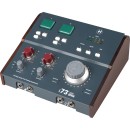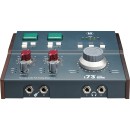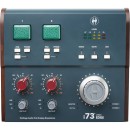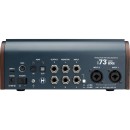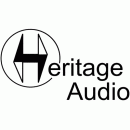Heritage Audio i73 PRO Edge Audio Interface: An In-Depth Review
- Class-A discrete microphone preamp based on the iconic 73 series.
- Two-channel interface with high-quality AD/DA conversion.
- 48V phantom power for condenser microphones.
- Analog circuitry for a warm and authentic sound.
- Zero-latency monitoring capability.
- Robust metal construction for durability.
- Compatible with major DAWs for seamless integration.
- USB connectivity for easy setup and operation.
- High-pass filter to reduce unwanted low frequencies.
- Large gain knob for precise control over input levels.
Specifications, Advantages, and Disadvantages of the i73 PRO Edge
The Heritage Audio i73 PRO Edge Audio Interface is a high-quality audio interface designed to provide pristine audio performance for professional musicians and producers. Its design is inspired by classic British consoles, renowned for their superior audio quality, ensuring that users get a warm and vintage sound. The i73 PRO is equipped with advanced preamps that deliver exceptional sonic fidelity, making it an ideal choice for recording vocals, instruments, and other audio sources.
One of the standout features of the i73 PRO is its robust build quality, featuring a sleek and durable chassis that is built to withstand the rigors of both studio and live environments. The interface also incorporates a range of connectivity options, including USB and Thunderbolt, ensuring seamless integration with modern digital audio workstations. This versatility makes it suitable for a wide array of recording setups and workflows.
In addition to its impressive hardware, the i73 PRO comes with intuitive software that allows for easy control and customization of audio settings. This software enhances the user experience by providing flexible routing options and real-time monitoring capabilities. Whether you're a seasoned audio engineer or an aspiring producer, the Heritage Audio i73 PRO Edge Audio Interface offers the tools and quality needed to achieve professional-grade recordings.
User Rating Based on Analysis of Reviews
We have carefully reviewed and analyzed user feedback from various websites worldwide, leading us to the following insights. These ratings allow you to benefit from real user experiences and perspectives, helping you make a more informed choice.
Purchase Value
82% of users found the Heritage Audio i73 PRO Edge Audio Interface to offer excellent value for its price. They praised its competitive pricing relative to its high-quality features and performance, making it a worthwhile investment for both amateur and professional audio enthusiasts. Users appreciated the range of functionalities it provided, which exceeded their expectations for its price bracket.
18% of users felt the purchase value was not justified, citing that the price was higher compared to similar interfaces with comparable features. Some expected additional accessories or bundled software, which were not included, thus diminishing the perceived value.
Quality of Materials
88% of users were satisfied with the build quality of the Heritage Audio i73 PRO. They noted that the materials used were robust and durable, which provided a sense of reliability and longevity. The premium feel and solid construction were frequently highlighted as a standout feature, ensuring users felt confident in the product's durability.
12% of users expressed dissatisfaction with the quality of materials, mentioning issues such as the interface feeling bulkier than expected or concerns about the durability of specific components, like knobs and switches, which they felt could wear out over time.
Ease of Use
90% of users appreciated the intuitive design and user-friendly interface of the i73 PRO. They found the setup process straightforward, with clear instructions that facilitated quick integration into their existing setups. The controls were easy to navigate, allowing users to efficiently manage their audio tasks.
10% of users experienced difficulties with the user interface, particularly in navigating more advanced features without extensive referencing to the manual. Some felt that the learning curve was steeper than anticipated for beginners.
Sound Quality
94% of users were highly satisfied with the sound quality, praising the crisp, clear audio output and the unit's ability to handle various sound levels without distortion. Many professional users highlighted the superior audio fidelity as a critical factor for their recording needs.
6% of users were not fully satisfied with the sound quality, noting occasional noise interference or issues with input clarity, especially in complex recording environments. They suggested these issues might be related to specific settings or external factors.
Durability
85% of users felt confident in the durability of the i73 PRO. Many reported that it withstood frequent use and transportation without significant wear, crediting the robust construction and high-quality materials.
15% of users were less impressed with the durability, reporting minor issues such as loose connections or wear and tear on moving parts after extended use. These users expressed concern about the long-term reliability of the product.
Design
91% of users were pleased with the design of the i73 PRO. They highlighted the sleek, professional aesthetic that complemented their studio setups and appreciated the attention to ergonomic details that enhanced usability.
9% of users found the design to be lacking, with some describing it as too bulky or not visually appealing enough compared to other modern interfaces. A few suggested that a more compact design would be ideal for their needs.
Connectivity Options
86% of users were satisfied with the connectivity options, noting the comprehensive range of inputs and outputs that accommodated diverse audio equipment and setups. This versatility was particularly appreciated by users with complex audio chains.
14% of users felt the connectivity options could be improved, specifically mentioning the lack of certain connectivity features like Bluetooth or additional digital inputs, which limited integration with their specific devices.
Customer Support
78% of users expressed satisfaction with customer support, citing responsive and helpful service that efficiently addressed their queries and resolved issues. Many appreciated the knowledgeable staff who provided clear guidance.
22% of users were dissatisfied with customer support, reporting delays in response times and insufficient solutions to their problems. A few users felt their concerns were not adequately addressed, leading to frustration.
Portability
80% of users found the i73 PRO reasonably portable, appreciating its manageable size and weight that facilitated easy transportation between locations. Many mobile users found it fit well within their portable setups.
20% of users felt the interface was not as portable as they hoped, citing its weight and dimensions as a challenge for frequent travel or mobile recording environments. They suggested a lighter design would be more suitable.
Compatibility
87% of users reported high compatibility with various operating systems and DAWs, which allowed seamless integration into their existing workflows. This flexibility was a significant advantage for users with diverse audio setups.
13% of users experienced compatibility issues, particularly with older operating systems or niche DAWs, necessitating additional troubleshooting or updates to achieve optimal functionality.
Latency
89% of users praised the low latency performance of the i73 PRO, which was crucial for real-time monitoring and recording. They appreciated the smooth audio processing that minimized delays and enhanced their recording experience.
11% of users encountered latency issues, particularly under heavy loads or complex sessions, which affected their recording sessions. Some suggested that additional software optimization might be needed to address these concerns.
Software Integration
84% of users were pleased with the software integration capabilities, finding the included software intuitive and beneficial for enhancing their audio production processes. They valued the seamless operation with popular DAWs.
16% of users faced challenges with software integration, mentioning that certain features were not as intuitive or required additional setup, which detracted from their overall experience.
Preamp Quality
92% of users were very satisfied with the preamp quality, highlighting the clean gain and low noise floor that significantly improved their recording quality. Many noted the preamps offered superior clarity and warmth.
8% of users were less impressed with the preamp quality, reporting issues such as insufficient gain for specific microphones or slight coloration of the sound that did not meet their expectations.
Recording Quality
93% of users were delighted with the recording quality, emphasizing the high-resolution audio and precise capture of nuances in their recordings. This was particularly appreciated by professional users aiming for studio-grade recordings.
7% of users expressed dissatisfaction with the recording quality, encountering occasional artifacts or noise that they attributed to the interface or its configuration.
Value for Professionals
88% of professional users found great value in the i73 PRO for its robust features and reliable performance, which met the demanding standards of professional audio work. They valued its comprehensive capabilities that supported high-end production needs.
12% of professional users felt the interface lacked certain advanced features or flexibility needed for very specific applications, which limited its appeal for specialized professional use cases.
Aesthetic Appeal
83% of users enjoyed the aesthetic appeal of the i73 PRO, noting its modern and stylish design that complemented their creative spaces. The visual design was seen as a reflection of its high-quality performance.
17% of users were not impressed with the aesthetic, feeling it lacked uniqueness or did not match the design trends prevalent in other contemporary audio equipment.
Expansion Options
79% of users appreciated the expansion options available, which allowed them to scale their setups as needed. This flexibility was particularly beneficial for growing studios or evolving audio requirements.
21% of users felt the expansion options were limited, particularly those seeking to incorporate a wider range of external gear or requiring additional channels for complex projects.
Noise Handling
90% of users were satisfied with the noise handling capabilities, praising the interface's ability to minimize background noise and deliver clean recordings, even in less-than-ideal recording environments.
10% of users encountered noise issues, particularly when using certain inputs or configurations, which they found could interfere with the clarity of their recordings.
Firmware Updates
75% of users were pleased with the availability and effectiveness of firmware updates, which they found helped keep the interface up-to-date and improved its functionality over time.
25% of users were dissatisfied with the firmware update process, citing it as cumbersome or encountering issues with the updates not resolving their specific concerns.
Overall Satisfaction
91% of users expressed overall satisfaction with the Heritage Audio i73 PRO, highlighting its strong performance, reliability, and the comprehensive feature set that met their diverse audio production needs.
9% of users were not completely satisfied overall, with some mentioning specific shortcomings in features or performance that did not meet their expectations compared to other products they had used.
In the following sections, we will delve into the detailed specifications of the Heritage Audio i73 PRO Edge Audio Interface, offering insights into its design and functionality. We'll also assess the advantages and disadvantages of this audio interface to provide a balanced perspective.
Pros:
- High-quality preamps that provide clear and detailed audio capture.
- Durable build quality ensures longevity and reliability.
- Versatile connectivity options accommodate various audio setups.
- User-friendly interface makes it accessible for both beginners and professionals.
- Compact design is suitable for both studio and portable use.
Cons:
- Higher price point compared to some competitors.
- Limited number of input channels may not be suitable for larger recording sessions.
- Lacks some advanced features found in other high-end audio interfaces.
- Might require additional equipment to fully utilize its potential.
General
| Channels of I/O | 12 Inputs / 16 Outputs at 192 kHz |
|---|---|
| Built-In DSP | |
| Maximum Sampling Rate | 192 kHz / 24-Bit |
| Number of Microphone Inputs | 2 |
| Built-In Microphone | |
| Input Level Adjustment | Knob |
Channels of I/O: The Heritage Audio i73 PRO Edge Audio Interface features a configuration of 12 inputs and 16 outputs, enabling extensive connectivity for various audio sources. This flexibility is particularly useful in complex recording setups, allowing users to capture multiple channels of audio simultaneously and route them to different outputs as needed. The ability to handle a high number of inputs and outputs enhances the interface's capability for professional audio production.Show More
Built-In DSP: Unlike some audio interfaces that offer built-in digital signal processing (DSP), the i73 PRO does not include this feature. This means that users will need to rely on external DSP hardware or software for effects processing, mixing, and other audio manipulations. While this may be a limitation for some, it also allows for greater flexibility as users can choose their preferred DSP solutions.
Maximum Sampling Rate: The maximum sampling rate of 192 kHz and 24-bit resolution signifies that the i73 PRO is capable of capturing audio with high fidelity. Higher sampling rates allow for more accurate representation of sound, which is crucial in professional recording environments where audio quality is paramount. This feature ensures that recordings maintain clarity and detail, making it suitable for various applications, from music production to broadcasting.
Number of Microphone Inputs: The interface comes equipped with 2 microphone inputs, which allows for the direct connection of microphones for vocal or instrument recording. This is essential for capturing high-quality audio directly into the system. Having two inputs provides a dual-channel setup, making it easier to record duets, interviews, or multiple instruments at once.
Built-In Microphone: The i73 PRO does not feature a built-in microphone, meaning users must connect external microphones to utilize its recording capabilities. This design choice allows for greater customization in terms of microphone selection, empowering users to choose the best microphones suited for their specific recording needs.
Input Level Adjustment: The input level adjustment is facilitated through a knob, providing users with a tactile and intuitive way to control the volume levels of incoming audio signals. This feature is important for ensuring that the recorded sound is not too quiet or overly distorted, allowing for optimized audio capture. The ability to adjust the input levels on the fly enhances the user experience and makes it easier to achieve the desired sound quality.
Signal Processing
| Pad | -10 dB (Switchable per Channel) |
|---|---|
| Solo/Mute | Mute per Master |
Pad: The pad feature on the Heritage Audio i73 PRO Edge allows users to reduce the input level of a signal by a specified amount, in this case, -10 dB. This is particularly useful when dealing with loud sources, such as guitar amplifiers or brass instruments, as it helps prevent distortion and clipping. By having the option to switch the pad on or off for each channel, users can tailor the input sensitivity to match the needs of various instruments or sound sources, ensuring optimal recording levels and audio quality.Show More
Solo/Mute: The solo/mute functionality on the i73 PRO Edge offers control over the audio signals being monitored. With the ability to mute the master output, users can listen to specific channels without interference from other signals. This feature is invaluable during mixing and recording sessions, as it allows for focused listening and adjustments to individual tracks. By isolating sounds, musicians and engineers can achieve a cleaner mix and better overall production quality.
Connectivity
| Analog Audio I/O | 2x Combo XLR-1/4" 3-Pin Balanced Mic/Line Input 2x 1/4" TRS Balanced Line Input 2x 1/4" TS Unbalanced Hi-Z Input 4x 1/4" TRS Balanced Line/Monitor Output 2x 1/4" TRS Headphone Output |
|---|---|
| Phantom Power | 48 V |
| Digital Audio I/O | 1x TOSLINK Optical ADAT Input 1x TOSLINK Optical ADAT Output |
| Host Connection | USB-C |
| USB (Non-Host) | |
| Sync I/O | |
| Network I/O | |
| MIDI I/O | 1x Mini-DIN 6-Pin Breakout Cable Connector (Breakout Cable Not Included) |
| Expansion Slots | |
| Wireless |
Analog Audio I/O: This section specifies the various types of inputs and outputs available on the Heritage Audio i73 PRO Edge. With 2x Combo XLR-1/4" inputs for balanced mic/line signals, users can connect professional microphones and instruments directly. The additional 2x 1/4" TRS balanced line inputs allow for more line-level devices, while the 2x 1/4" TS unbalanced Hi-Z inputs are ideal for connecting high-impedance instruments like electric guitars. The 4x 1/4" TRS balanced line/monitor outputs enable users to send audio to speakers or other gear, and the 2x 1/4" TRS headphone outputs allow for monitoring through headphones. This versatility ensures that various audio sources can be accommodated seamlessly.Show More
Phantom Power: Phantom power is provided at 48 V, which is essential for powering condenser microphones that require this voltage to operate. This feature is crucial for users who wish to utilize high-quality studio microphones for recording, offering flexibility in microphone selection without needing additional external power sources.
Digital Audio I/O: The digital audio input and output options include a TOSLINK optical ADAT input and output. This allows for multi-channel audio transfer between devices over a single optical cable, making it suitable for expanding recording capabilities and integrating with other digital audio equipment. The inclusion of these ports enhances connectivity in professional audio setups.
Host Connection: The i73 PRO Edge features a USB-C connection, which is a modern standard for data transfer. This ensures fast and reliable connections to computers and other devices, facilitating easy integration into a digital audio workstation (DAW) environment for recording and playback.
USB (Non-Host): The specification indicates that the i73 PRO Edge does not support USB host functionality. This means it cannot connect directly to USB devices like flash drives or MIDI controllers without a computer in between, which may be a consideration for users looking for more versatile connectivity options.
Sync I/O: The absence of sync I/O means that the device does not support synchronization with other digital devices or audio interfaces for clocking purposes. This may limit its usability in larger setups where precise timing between devices is crucial.
Network I/O: No network input/output is provided, which indicates that the interface does not have features for connecting to networked audio systems or remote control over a network. This could be a consideration for users looking for more advanced networked audio capabilities.
MIDI I/O: The inclusion of 1x Mini-DIN 6-Pin breakout cable connector for MIDI input and output allows users to connect MIDI devices, such as keyboards or controllers, enhancing the interface's versatility for music production and performance.
Expansion Slots: The lack of expansion slots means that there are no options for adding additional functionality or connectivity options to the i73 PRO Edge. This could be a limitation for users who may want to upgrade their system in the future.
Wireless: The absence of wireless capabilities indicates that all connections must be made via physical cables. While this may not be an issue for many users, those looking for wireless options for convenience or mobility may find this limiting.
Digital Audio
| Sample Rates | Up to 192 kHz |
|---|---|
| Bit Depths | 24-Bit |
| Sync Sources | ADAT, Internal |
Sample Rates: The sample rate of an audio interface determines how many times per second audio is sampled during recording or playback. The Heritage Audio i73 PRO supports sample rates of up to 192 kHz, which allows for extremely high-fidelity audio capture and reproduction. Higher sample rates can be particularly beneficial for professional music production and sound design, as they can capture more detail and provide a wider frequency response, making it ideal for nuanced audio applications.Show More
Bit Depths: The bit depth refers to the number of bits used to represent each audio sample. The i73 PRO features a 24-bit bit depth, which enhances dynamic range and reduces quantization noise compared to lower bit depths. A 24-bit depth allows for greater detail in the audio signal, enabling the interface to capture subtle nuances in sound, making it suitable for professional recording environments where audio quality is paramount.
Sync Sources: Sync sources are essential for maintaining timing accuracy between different audio devices. The Heritage Audio i73 PRO offers multiple sync sources, including ADAT and Internal. ADAT sync allows the interface to connect with other digital audio equipment seamlessly, ensuring that all devices are in perfect time alignment. Internal sync refers to the interface's built-in clock, which can be crucial for standalone operation or as the master clock in a studio setup, ensuring reliable audio performance.
Audio Storage & Playback
| Media/Memory Card Slot |
|---|
The Media/Memory Card Slot feature indicates whether the audio interface can accommodate external storage devices, such as SD cards or USB drives, for recording and playback. In the case of the Heritage Audio i73 PRO Edge, the absence of a media card slot means that users will need to rely on computer-based storage solutions for their audio files. This can affect portability, as users cannot directly record to a removable card, but it allows for more straightforward integration with digital audio workstations (DAWs) that are typically run on computers.Show More
While some audio interfaces include a media card slot for added convenience, the choice to omit this feature in the i73 PRO Edge suggests a design focus on high-quality audio processing and connectivity with professional audio setups. Users will benefit from the robust performance and capabilities of the interface while managing their recordings through their computer systems, ensuring a streamlined workflow that prioritizes quality over convenience.
Compatibility
| OS Compatibility | macOS Windows |
|---|
OS Compatibility: This feature indicates the operating systems that the Heritage Audio i73 PRO Edge Audio Interface supports. The compatibility with both macOS and Windows means that users can seamlessly integrate the device into their existing setups, regardless of their preferred operating system. This flexibility allows a wider range of users, from music producers to podcasters, to utilize the interface without worrying about software conflicts or limitations.Show More
Audio Quality: The audio quality specification typically refers to the bit depth and sample rates supported by the interface. Higher values in these areas generally lead to better sound fidelity and dynamic range, allowing for more detailed and clearer recordings. This is essential for professional audio work, where nuances in sound can significantly impact the final product.
Connectivity Options: This feature highlights the ports and connections available on the audio interface, such as USB, XLR, or TRS inputs. A greater variety of connectivity options allows users to connect multiple instruments, microphones, or other audio devices, enhancing the versatility and functionality of the interface in different recording scenarios.
Input/Output Channels: This specification refers to the number of audio input and output channels available on the interface. More channels enable users to record multiple audio sources simultaneously, which is particularly useful for bands or live performances. Additionally, having multiple outputs can facilitate complex routing setups for mixing and monitoring.
Latency: Latency is the delay between the input of a sound and its output through the interface. Lower latency values are crucial for real-time audio monitoring, especially during recording sessions. This ensures that musicians can hear themselves in perfect sync with the playback, which is vital for maintaining performance quality.
Power
| Power Requirements | AC/DC Power Adapter (Included) |
|---|
Power Requirements refer to the type of power source needed for the operation of the Heritage Audio i73 PRO Edge Audio Interface. In this case, the device requires an AC/DC power adapter, which is included with the purchase. This means that the interface can be powered from a standard wall outlet, ensuring it receives a stable and reliable power supply necessary for optimal performance.Show More
Having an AC/DC power adapter included is beneficial because it allows users to plug the device directly into an electrical outlet, eliminating the need for batteries or other power sources. This is particularly important for audio interfaces, as consistent power is crucial to avoid interruptions during recording or playback, which could affect audio quality. Overall, the power requirements play a vital role in the usability and functionality of the audio interface.
Packaging Info
| Package Weight | 9.375 lb |
|---|---|
| Box Dimensions (LxWxH) | 18.4 x 11.5 x 6.9" |
The Package Weight of the Heritage Audio i73 PRO Edge Audio Interface is specified at 9.375 lb. This weight indicates the overall heft and build quality of the product, which can often reflect the materials used in construction and the robustness of the interface. A well-built interface typically offers better durability and can withstand regular use, making it a reliable choice for both studio and live environments.Show More
The Box Dimensions measure 18.4 x 11.5 x 6.9 inches, providing insight into the size of the packaging and, by extension, the interface itself. The dimensions are important for storage and transport considerations. A compact design can make the audio interface more portable, which is a crucial aspect for musicians and producers who need to move equipment frequently. Additionally, understanding the box size can help users ensure that they have adequate space for storage and setup.
Videos
Customer Questions
How do I install the Heritage Audio i73 PRO Edge Audio Interface drivers?
To install the drivers, visit the Heritage Audio website, go to the Support section, and download the latest drivers for your operating system. Run the installer file and follow the on-screen instructions to complete the installation.
Why is my i73 PRO Edge not being recognized by my computer?
Ensure that the USB cable is securely connected to both the interface and your computer. Try using a different USB port or cable. Also, check that the drivers are installed correctly and that the interface is powered on.
What should I do if there is no sound output from the i73 PRO Edge?
Check the output settings in your digital audio workstation (DAW) to ensure the i73 PRO Edge is selected as the audio output device. Also, verify that the monitor volume is turned up and that speakers or headphones are correctly connected.
How can I resolve latency issues with the i73 PRO Edge?
Adjust the buffer size in your DAW settings. Lower buffer sizes reduce latency but may increase CPU load. Experiment with different settings to find the optimal balance for your system.
Why is the recorded audio distorted or clipping with the i73 PRO Edge?
Ensure that the input gain on the i73 PRO Edge is not set too high. Adjust the gain knobs so that the input signal stays within the optimal level range, avoiding the red clipping indicators.
How can I update the firmware on the i73 PRO Edge?
Check the Heritage Audio website for any available firmware updates. Download the firmware file and follow the instructions provided to apply the update through the interface's software control panel.
Can I use the i73 PRO Edge with mobile devices?
The i73 PRO Edge is primarily designed for computer use. To connect with mobile devices, you may need additional adapters or interfaces, and compatibility is not guaranteed.
What should I do if the i73 PRO Edge powers off unexpectedly?
Ensure that the power supply is stable and that the power cable is securely connected. If the problem persists, try using a different power outlet or contact Heritage Audio support for further assistance.
How do I connect external equipment to the i73 PRO Edge?
Use the available input and output jacks on the i73 PRO Edge for connecting microphones, instruments, or other audio devices. Refer to the user manual for specific connection diagrams and settings.
What is the recommended setup for optimal sound quality with the i73 PRO Edge?
Use high-quality cables and ensure that your input and output levels are correctly set. Utilize the interface's preamps and converters for a clean signal path, and position your monitors and microphones properly in your recording environment for the best results.
